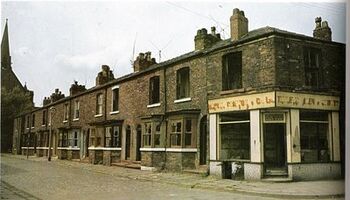
Archie Street in 1962
Archie Street was a terraced street in the Ordsall district of Salford which provided the design inspiration for the look of the fictional Coronation Street when the serial began in 1960. The late nineteenth century street was notably different in several ways to its television counterpart:
- There were terraced houses on both sides of the street with no Mission Hall or factory present. The side of the street that was used as the model for Coronation Street had eleven houses as opposed to the seven featured in the programme. The numbering of the houses ran in the opposite direction too (i.e. the corner shop on Archie Street was No.2).
- The Corner Shop end of the street did not have a railway viaduct but was instead crossed by Taylorson Street, then a major thoroughfare through Ordsall (a section of which still exists albeit very different in its current form) however there was a shop in the correct place whose outside appearance was closely used in the design of the television version. The name of the real-life shop in 1960 was "Daniel Clifton & Co. Ltd."
- There was no pub on Archie Street and the television "Rosamund Street" end was crossed in reality by Cavendish Street on which stood St. Clement's Church. This church still stands today and is useful for pinpointing the present-day location of where Archie Street once stood. When Coronation Street was studio based in the 1960s the "Rovers" end of the street also had a church on it - St. Mary's Church - and this was occasionally seen through the use of painted backdrops.
- The houses had a double-bay window at the front whereas the studio-built version had single bays, presumably to be able to fit the set into the confines of the cramped Studio Two at Granada Television's Quay Street studios.
Archie Street was chosen by Tony Warren and designer Denis Parkin in the autumn of 1960 as they drove round the Ordsall district looking for a suitable location on which to base the programme's set designs. The street was used in the first title sequence for the programme and also in various end-caption photographs. A filmed shot used throughout most of the 1960s from a high vantage point on Manchester Ship Canal dock buildings on Ordsall Lane also showed St. Clement's Church in the distance.

Riley and Lowry's joint sketch of Archie Street, made on 5th December 1960.
The acclaimed Salford artist Harold Riley, a friend of Tony Warren, was present when these sequences were shot as attested to by him on an etching that he and legendary artist L. S. Lowry collaborated with on 5th December 1960, just five days before the programme began. Riley’s text of that joint session read:
- I walked with Lowry on the 5th of December 1960 through the Ordsall area of Salford. He hardly walked this site of Broad Street or Chapel Street so I wanted to show him the streets. After Gertrude St (tea-leaf alley) we stopped at Archie street where Eddie Colman had lived. He was much taken with it, with the church at the end and the corner shop. We sketch briefly and then went to my studio and drew it again on a litho-stone. He'd never done the old process and was much interested in the etching. He added some figures to my drawing to see how they came out. He was delighted with the 5 palls, taking one and leaving me with 4 others.
The street featured in an early article about the programme in the listings magazine TV Times in the issue of 28th May to 3rd June 1961 when Warren, Doris Speed and Betty Alberge were photographed with the real residents and local MP Frank Allaun (a great supporter of the programme) on a publicity visit. The street became well known for its association with the programme and was nicknamed "Coronarchie Street".
As stated above, the street was also well known as being the birthplace, at No.9, of Manchester United "Busby Babe" Eddie Colman on 1st November 1936. The street has been referred to as the "spiritual home" of the Busby Babes and fellow player Bobby Charlton has spoken eloquently of spending Christmas Day with the Colmans, their friends, neighbours and extended family who all congregated at 9 Archie Street with jugs of beer supplied from the off licence at the corner shop. Colman later died in the Munich air disaster on 6th February 1958.

Archie Street prior to demolition
In 1968 the residents were moved out and the street stood derelict until 1971 when it was finally demolished. For the vast majority of the 1960s, scenes set on the fictional Coronation Street were recorded inside Granada's Quay Street studios although from April 1968 the production used the Grape Street set for outdoor scenes. Aside from the title sequence, no scenes were ever shot on Archie Street for the programme.
St Clement's Church aside, nothing now remains of either Archie Street or its immediate surrounding streets. The north-west end of St. Clement's Drive now stands on the site. St Clement's Church itself was used in the programme for the location filming for the wedding of Jerry Booth and Myra Dickinson in Episode 299 (23rd October 1963) although the main entrance to the church and its grounds were used which were on the opposite side of the building to Archie Street.








